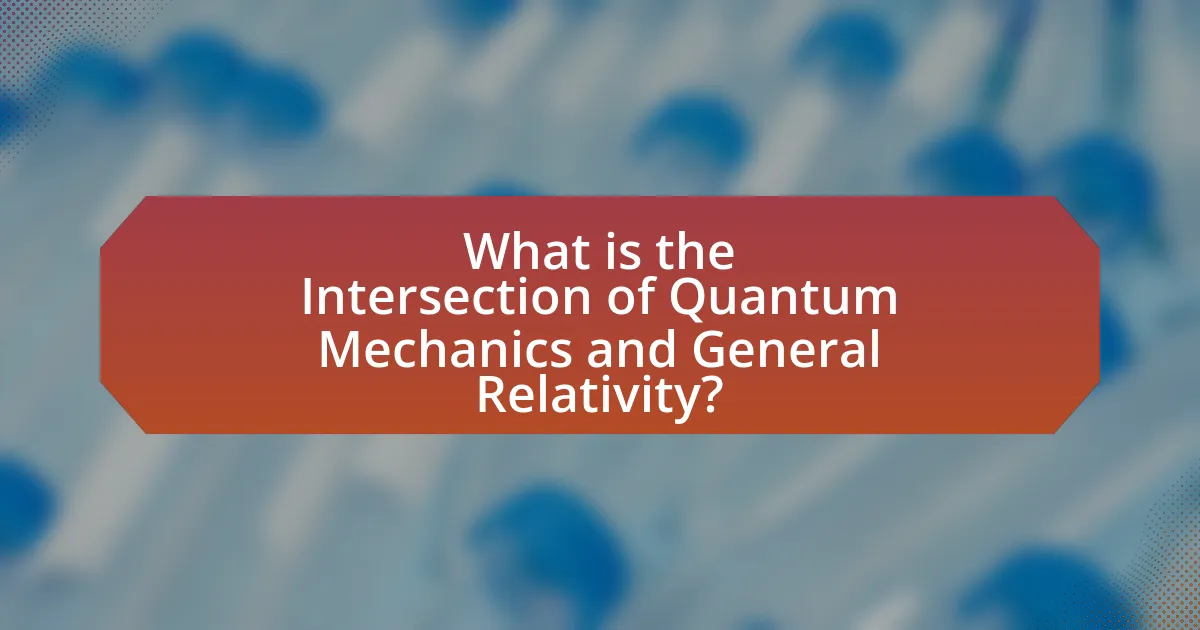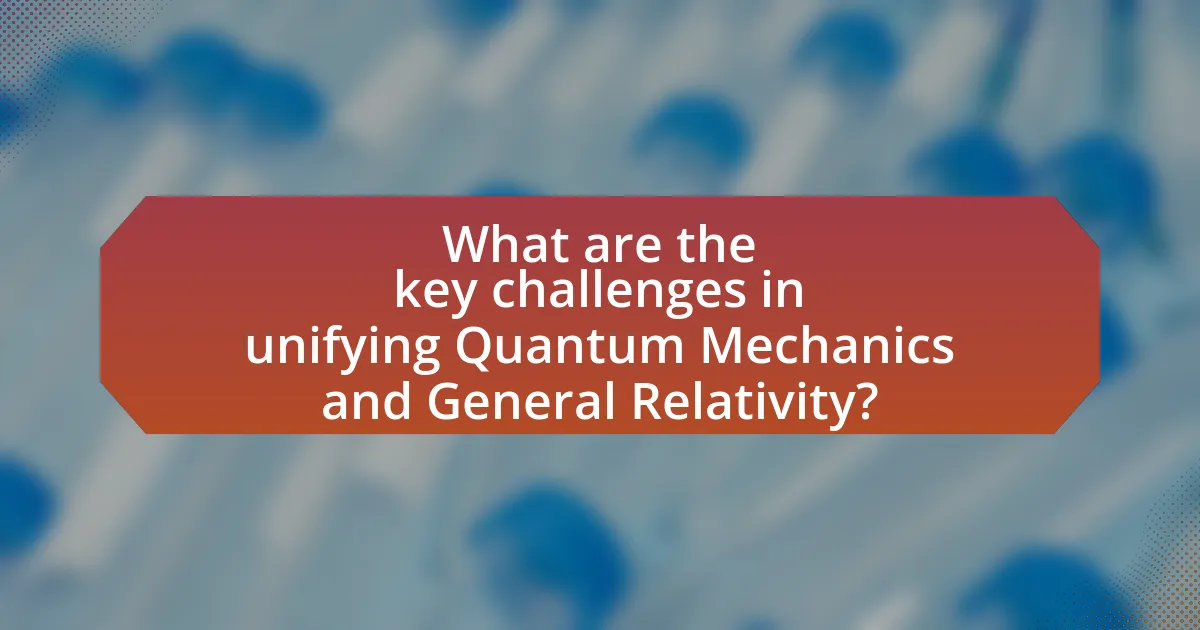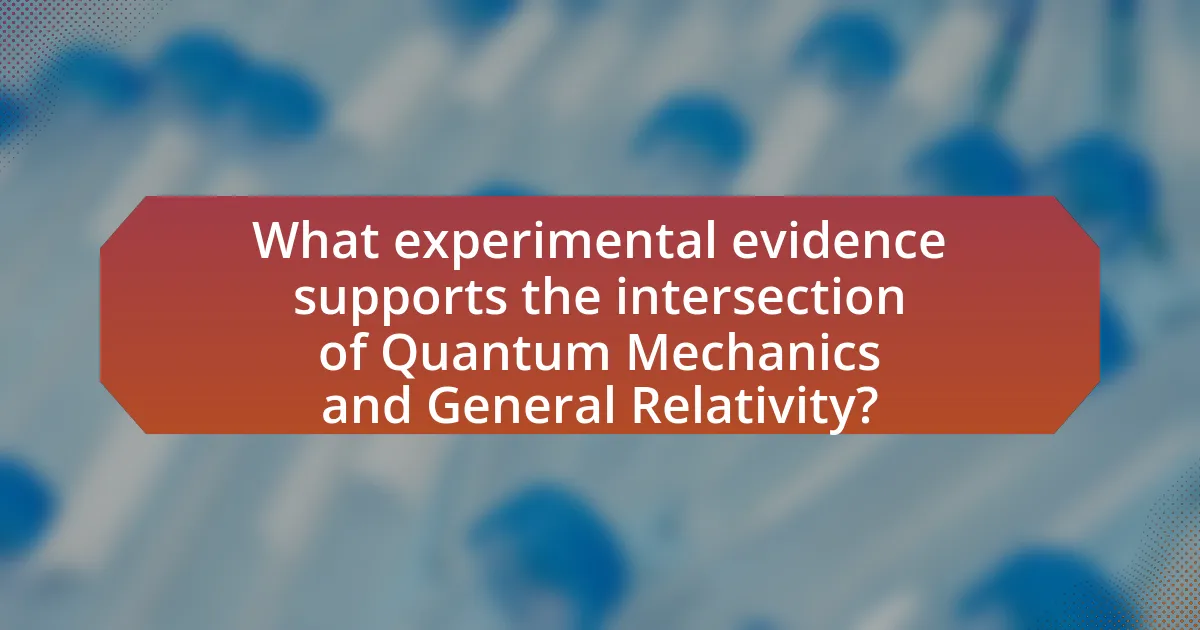The intersection of quantum mechanics and general relativity represents a critical area of theoretical physics that seeks to unify the principles governing subatomic particles with those describing gravitational forces and spacetime curvature. This article explores the fundamental differences between the two theories, including their core principles, and highlights the significance of their intersection in understanding phenomena such as black holes and the early universe. It also addresses the challenges and theoretical obstacles in achieving a unified framework, discusses leading theories like string theory and loop quantum gravity, and examines experimental evidence that supports their integration. Additionally, the article considers the implications of this unification for cosmology, technology, and our overall understanding of the universe.

What is the Intersection of Quantum Mechanics and General Relativity?
The intersection of quantum mechanics and general relativity refers to the theoretical framework that seeks to unify the principles of quantum physics, which governs the behavior of subatomic particles, with the principles of general relativity, which describes the gravitational force and the curvature of spacetime. This intersection is crucial for understanding phenomena such as black holes and the early universe, where both quantum effects and gravitational effects are significant. Current approaches to this unification include string theory and loop quantum gravity, which aim to reconcile the discrepancies between the two theories.
How do Quantum Mechanics and General Relativity differ fundamentally?
Quantum Mechanics and General Relativity differ fundamentally in their treatment of physical phenomena; Quantum Mechanics focuses on the behavior of particles at the smallest scales, emphasizing probabilistic outcomes and wave-particle duality, while General Relativity describes gravity as the curvature of spacetime caused by mass, operating on a macroscopic scale. Quantum Mechanics operates under principles such as superposition and entanglement, which have no equivalent in General Relativity, where the deterministic nature of spacetime geometry governs the motion of objects. This fundamental difference leads to challenges in unifying the two theories, as evidenced by the incompatibility of quantum field theories with gravitational effects, highlighting the need for a theory of quantum gravity to reconcile these frameworks.
What are the core principles of Quantum Mechanics?
The core principles of Quantum Mechanics include wave-particle duality, uncertainty principle, superposition, and entanglement. Wave-particle duality states that particles exhibit both wave-like and particle-like properties, as demonstrated by experiments such as the double-slit experiment. The uncertainty principle, formulated by Werner Heisenberg, asserts that certain pairs of physical properties, like position and momentum, cannot be simultaneously measured with arbitrary precision. Superposition refers to the ability of quantum systems to exist in multiple states at once until measured, exemplified by Schrödinger’s cat thought experiment. Lastly, entanglement describes a phenomenon where particles become interconnected, such that the state of one particle instantaneously influences the state of another, regardless of distance, as confirmed by experiments like those conducted by Alain Aspect. These principles form the foundation of Quantum Mechanics and have been validated through extensive experimental evidence.
What are the core principles of General Relativity?
The core principles of General Relativity are the equivalence principle, the curvature of spacetime, and the influence of mass on the geometry of spacetime. The equivalence principle states that the effects of gravity are indistinguishable from acceleration, meaning that locally, the laws of physics in a gravitational field are the same as those in an accelerating frame. The curvature of spacetime, described by Einstein’s field equations, indicates that massive objects like planets and stars warp the fabric of spacetime, causing the gravitational effects observed. This theory has been validated through various experiments, such as the observation of light bending around massive objects during solar eclipses, confirming that mass influences the geometry of spacetime.
Why is the intersection of these two theories significant?
The intersection of quantum mechanics and general relativity is significant because it addresses the fundamental discrepancies between the two theories, which describe the behavior of the universe at vastly different scales. This intersection is crucial for developing a unified theory of physics, as quantum mechanics governs the behavior of particles at the smallest scales, while general relativity explains the gravitational interactions of massive objects. The inability to reconcile these theories has led to major questions in theoretical physics, such as the nature of black holes and the conditions of the Big Bang. Research, such as that by Stephen Hawking on black hole thermodynamics, highlights the need for a coherent framework that integrates both theories, emphasizing the significance of their intersection in advancing our understanding of the universe.
How does this intersection challenge our understanding of physics?
The intersection of quantum mechanics and general relativity challenges our understanding of physics by revealing fundamental inconsistencies between the two theories. Quantum mechanics operates on principles of probability and uncertainty at microscopic scales, while general relativity describes gravity as a curvature of spacetime at macroscopic scales. This discrepancy leads to unresolved issues, such as the inability to reconcile black hole singularities with quantum behavior, as highlighted by the information paradox, which suggests that information may be lost in black holes, contradicting quantum theory’s tenet of information conservation. Additionally, attempts to formulate a unified theory, such as string theory, have yet to produce experimentally verifiable predictions, indicating that our current frameworks may be incomplete.
What implications does this intersection have for cosmology?
The intersection of quantum mechanics and general relativity has profound implications for cosmology, particularly in understanding the early universe and the nature of black holes. This intersection suggests that a unified theory, often referred to as quantum gravity, is necessary to accurately describe phenomena such as the Big Bang and the behavior of singularities. For instance, the application of quantum principles to cosmological models can lead to insights about the initial conditions of the universe, potentially resolving issues like the singularity problem where classical physics breaks down. Additionally, the study of black holes through the lens of both theories raises questions about information loss and the fate of matter, which are critical for the understanding of cosmic evolution. These implications highlight the need for a comprehensive framework that reconciles the principles of quantum mechanics with the geometric nature of spacetime described by general relativity.

What are the key challenges in unifying Quantum Mechanics and General Relativity?
The key challenges in unifying Quantum Mechanics and General Relativity include reconciling the fundamentally different frameworks of the two theories, particularly in their treatment of gravity and spacetime. Quantum Mechanics operates on probabilistic principles and discrete states, while General Relativity describes gravity as a curvature of spacetime, leading to difficulties in formulating a coherent theory that encompasses both.
One major challenge is the incompatibility of the smooth spacetime of General Relativity with the quantum fluctuations inherent in Quantum Mechanics, which become significant at the Planck scale. Additionally, the lack of a quantum theory of gravity, which would provide a framework for understanding gravitational interactions at quantum levels, further complicates efforts to unify the two theories.
Historical attempts, such as string theory and loop quantum gravity, have sought to address these issues but have yet to produce a universally accepted solution. The ongoing research highlights the complexity of merging these foundational aspects of physics, underscoring the need for a new theoretical approach that can bridge the gap between the two.
What are the main theoretical obstacles to unification?
The main theoretical obstacles to unification between quantum mechanics and general relativity include the incompatibility of their fundamental principles and the lack of a consistent framework that integrates both theories. Quantum mechanics operates on probabilistic outcomes and discrete states, while general relativity describes gravity as a smooth curvature of spacetime. This fundamental difference creates challenges in reconciling the two theories, particularly in extreme conditions such as black holes or the Big Bang, where both quantum effects and gravitational forces are significant. Additionally, the absence of a quantum theory of gravity, which would provide a coherent description of gravitational interactions at the quantum level, further complicates efforts toward unification.
How does the concept of spacetime conflict with quantum principles?
The concept of spacetime conflicts with quantum principles primarily due to the incompatibility between the deterministic nature of general relativity and the probabilistic nature of quantum mechanics. General relativity describes gravity as the curvature of spacetime caused by mass, leading to a smooth, continuous model of the universe. In contrast, quantum mechanics operates on discrete states and uncertainties, exemplified by phenomena such as wave-particle duality and the Heisenberg uncertainty principle. This fundamental difference creates challenges in reconciling the two theories, particularly in extreme conditions like black holes, where spacetime curvature becomes extreme and quantum effects cannot be ignored. The lack of a unified framework that incorporates both quantum mechanics and general relativity, often referred to as the quest for a theory of quantum gravity, underscores this conflict.
What role does gravity play in quantum systems?
Gravity plays a significant role in quantum systems by influencing the behavior of particles at a fundamental level. In quantum mechanics, gravity is often treated as a classical force, but its effects become crucial in scenarios involving strong gravitational fields, such as near black holes or during the early universe. Research indicates that the integration of gravity into quantum mechanics is essential for understanding phenomena like quantum entanglement and the behavior of particles in curved spacetime, as highlighted in studies on quantum gravity. For instance, the work of physicists like Carlo Rovelli and Lee Smolin in loop quantum gravity illustrates how gravity can affect the fabric of spacetime at the quantum level, suggesting that spacetime itself may have a discrete structure.
How have physicists attempted to address these challenges?
Physicists have attempted to address the challenges at the intersection of quantum mechanics and general relativity through various theoretical frameworks and models. One prominent approach is the development of string theory, which posits that fundamental particles are one-dimensional strings rather than point-like objects, potentially unifying the two theories. Additionally, loop quantum gravity has emerged as a competing theory, aiming to quantize spacetime itself and reconcile the principles of quantum mechanics with the geometric nature of general relativity. Research such as “A Brief History of String Theory” by Michael Green and John Schwarz highlights the ongoing efforts to formulate a consistent theory that encompasses both realms. These approaches illustrate the diverse strategies physicists employ to tackle the complexities arising from the incompatibility of quantum mechanics and general relativity.
What are the leading theories in quantum gravity?
The leading theories in quantum gravity include string theory, loop quantum gravity, and causal set theory. String theory posits that fundamental particles are one-dimensional strings rather than point-like objects, aiming to unify quantum mechanics and general relativity. Loop quantum gravity, on the other hand, attempts to quantize spacetime itself, suggesting that space is composed of discrete loops. Causal set theory proposes that spacetime is a discrete set of events ordered by causality, providing a different approach to understanding gravity at the quantum level. These theories are significant as they seek to reconcile the principles of quantum mechanics with the geometric nature of gravity described by general relativity.
How do string theory and loop quantum gravity propose solutions?
String theory and loop quantum gravity propose solutions to the unification of quantum mechanics and general relativity by offering distinct frameworks for understanding the fundamental nature of space, time, and matter. String theory posits that the basic building blocks of the universe are one-dimensional strings rather than point particles, allowing for a consistent quantum description of gravity and the other fundamental forces. This approach leads to the prediction of additional dimensions and the potential for a unified theory that incorporates all forces of nature, as evidenced by its mathematical consistency in higher-dimensional spaces.
Loop quantum gravity, on the other hand, directly quantizes spacetime itself, suggesting that space is composed of discrete loops or networks, which leads to a granular structure at the Planck scale. This theory provides a framework for understanding black hole entropy and the Big Bang singularity, as it avoids the infinities that arise in classical general relativity. The mathematical formulation of loop quantum gravity has been supported by results that indicate the quantization of areas and volumes, reinforcing its validity as a competing theory to string theory in addressing the challenges of merging quantum mechanics with general relativity.

What experimental evidence supports the intersection of Quantum Mechanics and General Relativity?
Experimental evidence supporting the intersection of Quantum Mechanics and General Relativity includes observations of black hole thermodynamics and Hawking radiation. Theoretical predictions suggest that black holes emit radiation due to quantum effects near the event horizon, leading to the concept of black hole entropy. This aligns with the principles of quantum mechanics while also adhering to the framework of general relativity. Additionally, experiments involving quantum entanglement and gravitational waves, such as those detected by LIGO, hint at the potential for a unified theory, as they demonstrate how quantum states can be influenced by gravitational fields. These findings collectively indicate a deeper connection between the two fundamental theories.
What experiments have been conducted to test these theories together?
Experiments that have been conducted to test the theories of quantum mechanics and general relativity together include the study of black hole thermodynamics and the behavior of particles in strong gravitational fields. One significant experiment is the observation of Hawking radiation, which predicts that black holes emit radiation due to quantum effects near the event horizon. This phenomenon was theoretically proposed by Stephen Hawking in 1974 and has been a focal point for testing the compatibility of quantum mechanics with general relativity. Additionally, experiments involving gravitational wave detection, such as those conducted by LIGO, have provided insights into the quantum states of particles in extreme gravitational environments, further exploring the intersection of these two fundamental theories.
How do black holes provide insights into this intersection?
Black holes provide insights into the intersection of quantum mechanics and general relativity by presenting extreme conditions where both theories must be reconciled. The event horizon of a black hole challenges classical notions of spacetime, suggesting that quantum effects, such as Hawking radiation, emerge from these regions. Hawking’s theory posits that black holes can emit radiation due to quantum fluctuations near the event horizon, leading to the possibility of black hole evaporation. This phenomenon illustrates how quantum mechanics can influence gravitational systems, thereby highlighting the need for a unified theory that encompasses both frameworks. The study of black holes thus serves as a critical testing ground for theories that aim to merge quantum mechanics with general relativity, as evidenced by ongoing research in theoretical physics and astrophysics.
What role do gravitational waves play in understanding this relationship?
Gravitational waves serve as a crucial tool for understanding the relationship between quantum mechanics and general relativity by providing empirical evidence of phenomena predicted by general relativity, such as the merging of black holes and neutron stars. These waves, detected by observatories like LIGO and Virgo, confirm the existence of dynamic spacetime distortions, which can be analyzed to explore the fundamental principles of both theories. The detection of gravitational waves allows scientists to test the limits of general relativity in extreme conditions, potentially revealing insights into quantum gravity, a theory that seeks to unify quantum mechanics and general relativity.
What future experiments could further explore this intersection?
Future experiments that could further explore the intersection of quantum mechanics and general relativity include the use of quantum entanglement to test the effects of gravity on quantum states. Research by scientists such as Anton Zeilinger has demonstrated that entangled particles can exhibit correlations that challenge classical intuitions about locality and separability, suggesting that gravity may influence quantum behavior. Additionally, experiments utilizing advanced gravitational wave detectors, like LIGO, could investigate how quantum fluctuations in spacetime affect gravitational waves, potentially revealing insights into the unification of these two fundamental theories. These experimental approaches aim to provide empirical data that could validate or refute theoretical models attempting to bridge quantum mechanics and general relativity.
How might advancements in technology aid in this exploration?
Advancements in technology can significantly aid the exploration of the intersection of quantum mechanics and general relativity by providing enhanced computational power and sophisticated experimental tools. For instance, quantum computers can process complex calculations that are essential for simulating quantum systems, which is crucial for understanding phenomena where both quantum mechanics and general relativity are relevant, such as black holes. Additionally, technologies like gravitational wave detectors, exemplified by LIGO, enable the observation of cosmic events that can test theories unifying these two fundamental areas of physics. These advancements facilitate more precise measurements and deeper insights into the fundamental nature of the universe, thereby advancing theoretical and experimental physics.
What are the potential discoveries that could arise from future research?
Future research at the intersection of quantum mechanics and general relativity could lead to groundbreaking discoveries such as a unified theory of quantum gravity, which would reconcile the principles of both fields. This unification could provide insights into the behavior of black holes, potentially revealing how quantum effects influence their formation and evaporation, as suggested by Stephen Hawking’s theories. Additionally, advancements in understanding spacetime at quantum scales may lead to new technologies, such as quantum computing systems that leverage gravitational effects, enhancing computational power significantly. These discoveries could fundamentally alter our understanding of the universe, as evidenced by ongoing experiments in particle physics and astrophysics that aim to test the limits of current theories.
What practical applications could emerge from unifying Quantum Mechanics and General Relativity?
Unifying Quantum Mechanics and General Relativity could lead to practical applications such as advanced quantum computing, enhanced gravitational wave detection, and breakthroughs in energy generation through quantum gravity effects. Quantum computing could achieve unprecedented processing power by leveraging quantum states in a gravitational context, potentially solving complex problems in real-time. Enhanced gravitational wave detection would improve our understanding of cosmic events, enabling more precise measurements and insights into the universe’s structure. Additionally, harnessing quantum gravity could lead to new energy sources, as theoretical models suggest that manipulating spacetime at quantum levels might unlock previously unattainable energy efficiencies. These applications are grounded in ongoing research, such as the work by researchers at the Institute for Advanced Study, which explores the implications of quantum gravity on technology and energy systems.
How could this unification impact technology and innovation?
The unification of quantum mechanics and general relativity could revolutionize technology and innovation by enabling advancements in quantum computing and gravitational wave detection. This integration would allow for the development of new algorithms that leverage quantum entanglement and superposition, significantly enhancing computational power and efficiency. For instance, quantum computers could solve complex problems in seconds that would take classical computers thousands of years, as demonstrated by Google’s 2019 achievement of quantum supremacy. Additionally, improved understanding of gravitational waves could lead to innovations in communication technologies and navigation systems, as evidenced by the successful detection of gravitational waves by LIGO, which opened new avenues for astrophysical research and technology applications.
What are the potential benefits for our understanding of the universe?
The potential benefits for our understanding of the universe include enhanced insights into fundamental physical laws and the unification of disparate theories. By exploring the intersection of quantum mechanics and general relativity, researchers can develop a more comprehensive framework that explains phenomena such as black holes and the behavior of particles at subatomic levels. For instance, advancements in quantum gravity theories, like loop quantum gravity, aim to reconcile the principles of quantum mechanics with general relativity, potentially leading to breakthroughs in our understanding of the cosmos. This integration could also inform technological innovations, such as quantum computing and advanced materials, which stem from a deeper grasp of the universe’s underlying structure.




